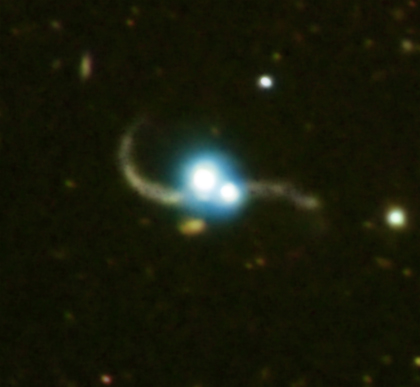Submitted by chandra on Wed, 2010-03-03 09:40
Submitted by chandra on Wed, 2010-02-03 16:37

This composite image shows the effects of two galaxies caught in the act of merging. A Chandra X-ray Observatory image shows a pair of quasars in blue, located about 4.6 billion light years away, but separated on the sky by only about 70 thousand light years. These bright sources, collectively called SDSS J1254+0846, are powered by material falling onto supermassive black holes. An optical image from the Baade-Magellan telescope in Chile, in yellow, shows tidal tails - gravitational-stripped streamers of stars and gas -- fanning out from the two colliding galaxies.
Submitted by chandra on Thu, 2009-05-14 11:15
Activity from a supermassive black hole is responsible for the intriguing appearance of this galaxy, 3C305, located about 600 million light years away from Earth. The structures in red and light blue are X-ray and optical images from the Chandra X-ray Observatory and Hubble Space Telescope respectively. The optical data is from oxygen emission only, and therefore the full extent of the galaxy is not seen.
Submitted by chandra on Fri, 2009-01-30 13:27
This image of Centaurus A shows a spectacular new view of a supermassive black hole's power. Jets and lobes powered by the central black hole in this nearby galaxy are shown by submillimeter data (colored orange) from the Atacama Pathfinder Experiment (APEX) telescope in Chile and X-ray data (colored blue) from the Chandra X-ray Observatory. Visible light data from the Wide Field Imager on the Max-Planck/ESO 2.2 m telescope, also located in Chile, shows the dust lane in the galaxy and background stars.
Submitted by chandra on Wed, 2008-08-20 16:22
We recently featured a composite image of Chandra and Hubble data of the object known as M87. This object, which gets its name from being the 87th object in Charles Messier's catalog, is the giant elliptical galaxy in what is known as the Virgo Cluster. If you are interested in astronomy, you have probably heard of the Virgo Cluster. What makes this cluster of galaxies so important that it seems like astronomers use every type of telescope to study it?
Submitted by chandra on Mon, 2008-02-25 12:12
Hello! Hopefully by now you'll have read a little about 3C 321, aka the "Death Star Galaxy" from
Submitted by chandra on Wed, 2008-02-13 13:31
Dr. Dan Evans from the Harvard-Smithsonian Center for Astrophysics in Cambridge, MA, shares some information on 3c321, as of December 2007 now known as the Death Star Galaxy. Dan Evans has never seen Star Wars, so who came up with the nickname? Read on.
Pages